BSc Nursing (LD): Comparing LD Nursing Roles (1980s & Today)
VerifiedAdded on 2020/05/28
|13
|3581
|168
Essay
AI Summary
This essay delves into the historical context and evolution of learning disability (LD) nursing, comparing the role of registered nurses in the field from the 1980s to the present day. It explores the core concepts of LD, the responsibilities of LD nurses, and the significant shifts in practice, values, and scope of work. The essay highlights the challenges faced by LD nurses in the past, including a lack of role clarity and the marginalization of the profession, contrasting this with the current emphasis on professionalism, accountability, and the diverse roles LD nurses play in public health and community settings. It emphasizes the importance of specialist care, patient-centered approaches, and collaboration with multidisciplinary teams. The essay also provides statistics on the prevalence of LD and discusses how societal and healthcare changes have influenced the expectations and responsibilities of LD nurses, making their role more critical and valued today than in the past.
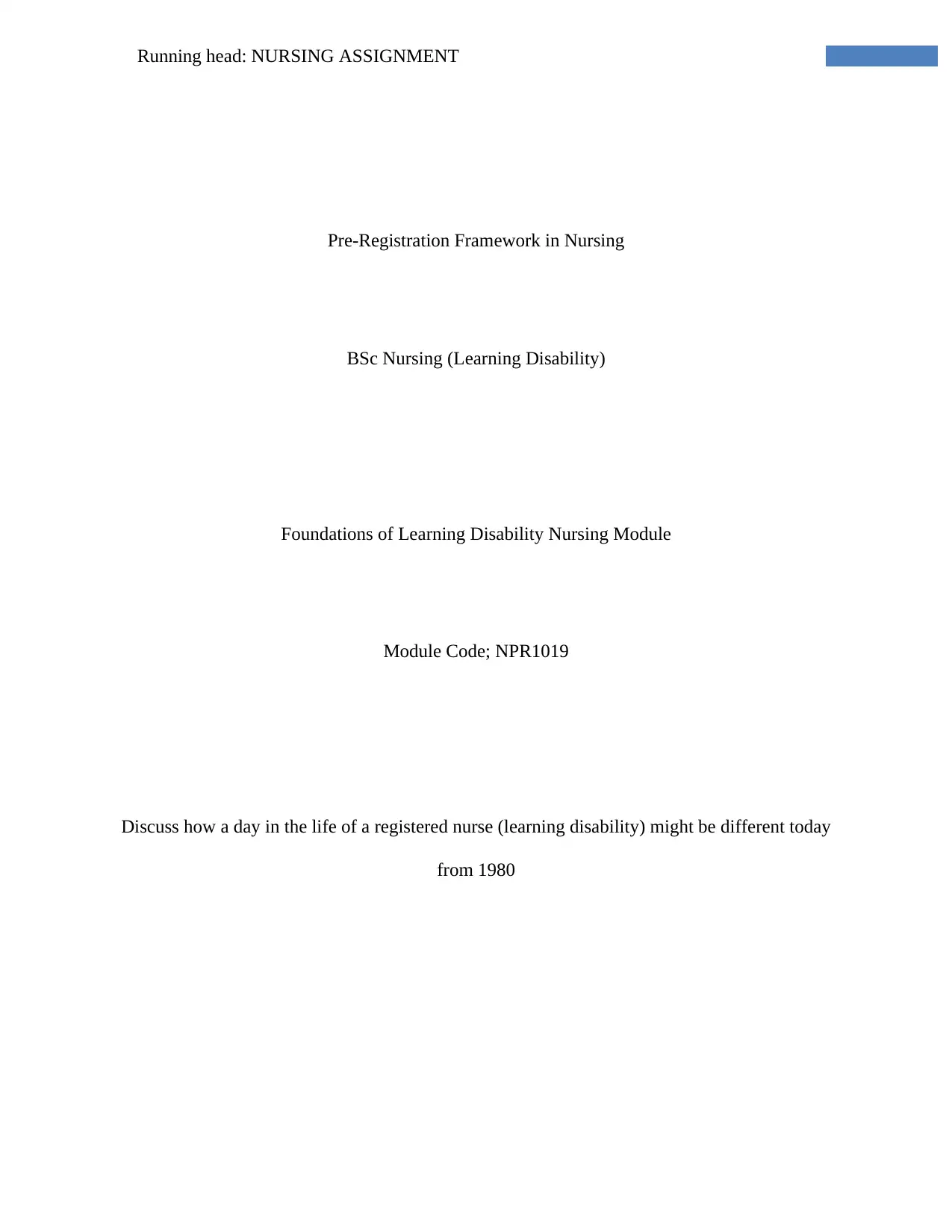
Running head: NURSING ASSIGNMENT
Pre-Registration Framework in Nursing
BSc Nursing (Learning Disability)
Foundations of Learning Disability Nursing Module
Module Code; NPR1019
Discuss how a day in the life of a registered nurse (learning disability) might be different today
from 1980
Pre-Registration Framework in Nursing
BSc Nursing (Learning Disability)
Foundations of Learning Disability Nursing Module
Module Code; NPR1019
Discuss how a day in the life of a registered nurse (learning disability) might be different today
from 1980
Paraphrase This Document
Need a fresh take? Get an instant paraphrase of this document with our AI Paraphraser
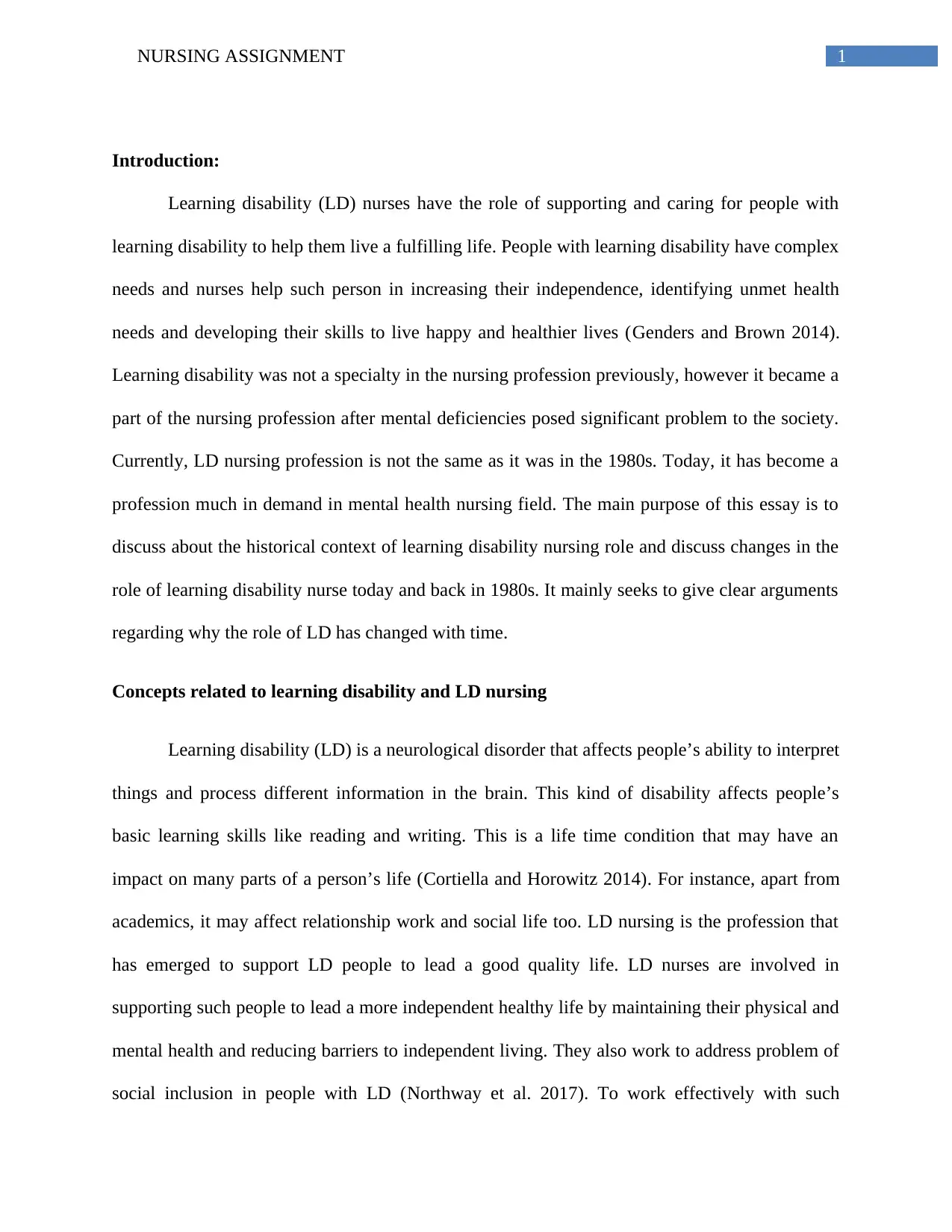
1NURSING ASSIGNMENT
Introduction:
Learning disability (LD) nurses have the role of supporting and caring for people with
learning disability to help them live a fulfilling life. People with learning disability have complex
needs and nurses help such person in increasing their independence, identifying unmet health
needs and developing their skills to live happy and healthier lives (Genders and Brown 2014).
Learning disability was not a specialty in the nursing profession previously, however it became a
part of the nursing profession after mental deficiencies posed significant problem to the society.
Currently, LD nursing profession is not the same as it was in the 1980s. Today, it has become a
profession much in demand in mental health nursing field. The main purpose of this essay is to
discuss about the historical context of learning disability nursing role and discuss changes in the
role of learning disability nurse today and back in 1980s. It mainly seeks to give clear arguments
regarding why the role of LD has changed with time.
Concepts related to learning disability and LD nursing
Learning disability (LD) is a neurological disorder that affects people’s ability to interpret
things and process different information in the brain. This kind of disability affects people’s
basic learning skills like reading and writing. This is a life time condition that may have an
impact on many parts of a person’s life (Cortiella and Horowitz 2014). For instance, apart from
academics, it may affect relationship work and social life too. LD nursing is the profession that
has emerged to support LD people to lead a good quality life. LD nurses are involved in
supporting such people to lead a more independent healthy life by maintaining their physical and
mental health and reducing barriers to independent living. They also work to address problem of
social inclusion in people with LD (Northway et al. 2017). To work effectively with such
Introduction:
Learning disability (LD) nurses have the role of supporting and caring for people with
learning disability to help them live a fulfilling life. People with learning disability have complex
needs and nurses help such person in increasing their independence, identifying unmet health
needs and developing their skills to live happy and healthier lives (Genders and Brown 2014).
Learning disability was not a specialty in the nursing profession previously, however it became a
part of the nursing profession after mental deficiencies posed significant problem to the society.
Currently, LD nursing profession is not the same as it was in the 1980s. Today, it has become a
profession much in demand in mental health nursing field. The main purpose of this essay is to
discuss about the historical context of learning disability nursing role and discuss changes in the
role of learning disability nurse today and back in 1980s. It mainly seeks to give clear arguments
regarding why the role of LD has changed with time.
Concepts related to learning disability and LD nursing
Learning disability (LD) is a neurological disorder that affects people’s ability to interpret
things and process different information in the brain. This kind of disability affects people’s
basic learning skills like reading and writing. This is a life time condition that may have an
impact on many parts of a person’s life (Cortiella and Horowitz 2014). For instance, apart from
academics, it may affect relationship work and social life too. LD nursing is the profession that
has emerged to support LD people to lead a good quality life. LD nurses are involved in
supporting such people to lead a more independent healthy life by maintaining their physical and
mental health and reducing barriers to independent living. They also work to address problem of
social inclusion in people with LD (Northway et al. 2017). To work effectively with such
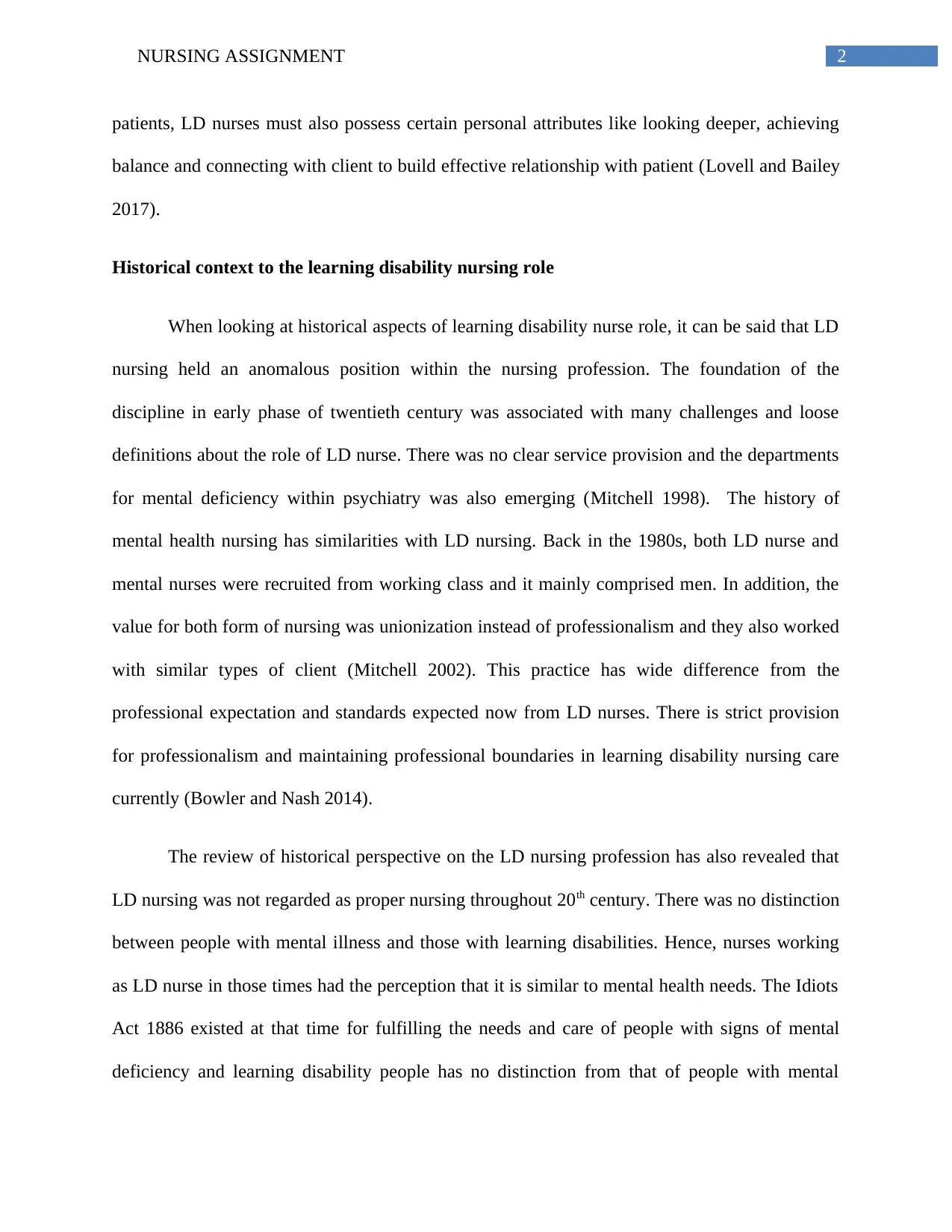
2NURSING ASSIGNMENT
patients, LD nurses must also possess certain personal attributes like looking deeper, achieving
balance and connecting with client to build effective relationship with patient (Lovell and Bailey
2017).
Historical context to the learning disability nursing role
When looking at historical aspects of learning disability nurse role, it can be said that LD
nursing held an anomalous position within the nursing profession. The foundation of the
discipline in early phase of twentieth century was associated with many challenges and loose
definitions about the role of LD nurse. There was no clear service provision and the departments
for mental deficiency within psychiatry was also emerging (Mitchell 1998). The history of
mental health nursing has similarities with LD nursing. Back in the 1980s, both LD nurse and
mental nurses were recruited from working class and it mainly comprised men. In addition, the
value for both form of nursing was unionization instead of professionalism and they also worked
with similar types of client (Mitchell 2002). This practice has wide difference from the
professional expectation and standards expected now from LD nurses. There is strict provision
for professionalism and maintaining professional boundaries in learning disability nursing care
currently (Bowler and Nash 2014).
The review of historical perspective on the LD nursing profession has also revealed that
LD nursing was not regarded as proper nursing throughout 20th century. There was no distinction
between people with mental illness and those with learning disabilities. Hence, nurses working
as LD nurse in those times had the perception that it is similar to mental health needs. The Idiots
Act 1886 existed at that time for fulfilling the needs and care of people with signs of mental
deficiency and learning disability people has no distinction from that of people with mental
patients, LD nurses must also possess certain personal attributes like looking deeper, achieving
balance and connecting with client to build effective relationship with patient (Lovell and Bailey
2017).
Historical context to the learning disability nursing role
When looking at historical aspects of learning disability nurse role, it can be said that LD
nursing held an anomalous position within the nursing profession. The foundation of the
discipline in early phase of twentieth century was associated with many challenges and loose
definitions about the role of LD nurse. There was no clear service provision and the departments
for mental deficiency within psychiatry was also emerging (Mitchell 1998). The history of
mental health nursing has similarities with LD nursing. Back in the 1980s, both LD nurse and
mental nurses were recruited from working class and it mainly comprised men. In addition, the
value for both form of nursing was unionization instead of professionalism and they also worked
with similar types of client (Mitchell 2002). This practice has wide difference from the
professional expectation and standards expected now from LD nurses. There is strict provision
for professionalism and maintaining professional boundaries in learning disability nursing care
currently (Bowler and Nash 2014).
The review of historical perspective on the LD nursing profession has also revealed that
LD nursing was not regarded as proper nursing throughout 20th century. There was no distinction
between people with mental illness and those with learning disabilities. Hence, nurses working
as LD nurse in those times had the perception that it is similar to mental health needs. The Idiots
Act 1886 existed at that time for fulfilling the needs and care of people with signs of mental
deficiency and learning disability people has no distinction from that of people with mental
⊘ This is a preview!⊘
Do you want full access?
Subscribe today to unlock all pages.

Trusted by 1+ million students worldwide
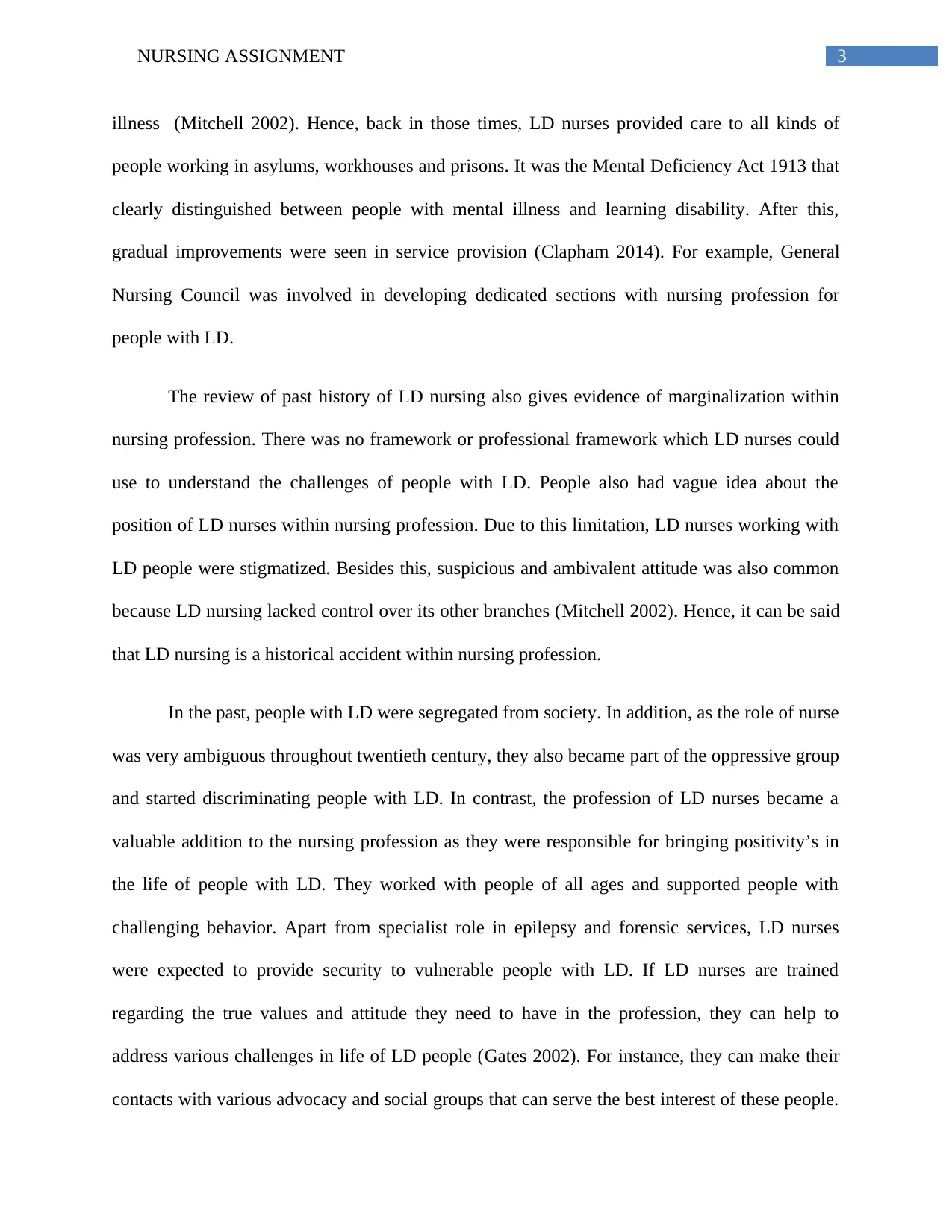
3NURSING ASSIGNMENT
illness (Mitchell 2002). Hence, back in those times, LD nurses provided care to all kinds of
people working in asylums, workhouses and prisons. It was the Mental Deficiency Act 1913 that
clearly distinguished between people with mental illness and learning disability. After this,
gradual improvements were seen in service provision (Clapham 2014). For example, General
Nursing Council was involved in developing dedicated sections with nursing profession for
people with LD.
The review of past history of LD nursing also gives evidence of marginalization within
nursing profession. There was no framework or professional framework which LD nurses could
use to understand the challenges of people with LD. People also had vague idea about the
position of LD nurses within nursing profession. Due to this limitation, LD nurses working with
LD people were stigmatized. Besides this, suspicious and ambivalent attitude was also common
because LD nursing lacked control over its other branches (Mitchell 2002). Hence, it can be said
that LD nursing is a historical accident within nursing profession.
In the past, people with LD were segregated from society. In addition, as the role of nurse
was very ambiguous throughout twentieth century, they also became part of the oppressive group
and started discriminating people with LD. In contrast, the profession of LD nurses became a
valuable addition to the nursing profession as they were responsible for bringing positivity’s in
the life of people with LD. They worked with people of all ages and supported people with
challenging behavior. Apart from specialist role in epilepsy and forensic services, LD nurses
were expected to provide security to vulnerable people with LD. If LD nurses are trained
regarding the true values and attitude they need to have in the profession, they can help to
address various challenges in life of LD people (Gates 2002). For instance, they can make their
contacts with various advocacy and social groups that can serve the best interest of these people.
illness (Mitchell 2002). Hence, back in those times, LD nurses provided care to all kinds of
people working in asylums, workhouses and prisons. It was the Mental Deficiency Act 1913 that
clearly distinguished between people with mental illness and learning disability. After this,
gradual improvements were seen in service provision (Clapham 2014). For example, General
Nursing Council was involved in developing dedicated sections with nursing profession for
people with LD.
The review of past history of LD nursing also gives evidence of marginalization within
nursing profession. There was no framework or professional framework which LD nurses could
use to understand the challenges of people with LD. People also had vague idea about the
position of LD nurses within nursing profession. Due to this limitation, LD nurses working with
LD people were stigmatized. Besides this, suspicious and ambivalent attitude was also common
because LD nursing lacked control over its other branches (Mitchell 2002). Hence, it can be said
that LD nursing is a historical accident within nursing profession.
In the past, people with LD were segregated from society. In addition, as the role of nurse
was very ambiguous throughout twentieth century, they also became part of the oppressive group
and started discriminating people with LD. In contrast, the profession of LD nurses became a
valuable addition to the nursing profession as they were responsible for bringing positivity’s in
the life of people with LD. They worked with people of all ages and supported people with
challenging behavior. Apart from specialist role in epilepsy and forensic services, LD nurses
were expected to provide security to vulnerable people with LD. If LD nurses are trained
regarding the true values and attitude they need to have in the profession, they can help to
address various challenges in life of LD people (Gates 2002). For instance, they can make their
contacts with various advocacy and social groups that can serve the best interest of these people.
Paraphrase This Document
Need a fresh take? Get an instant paraphrase of this document with our AI Paraphraser
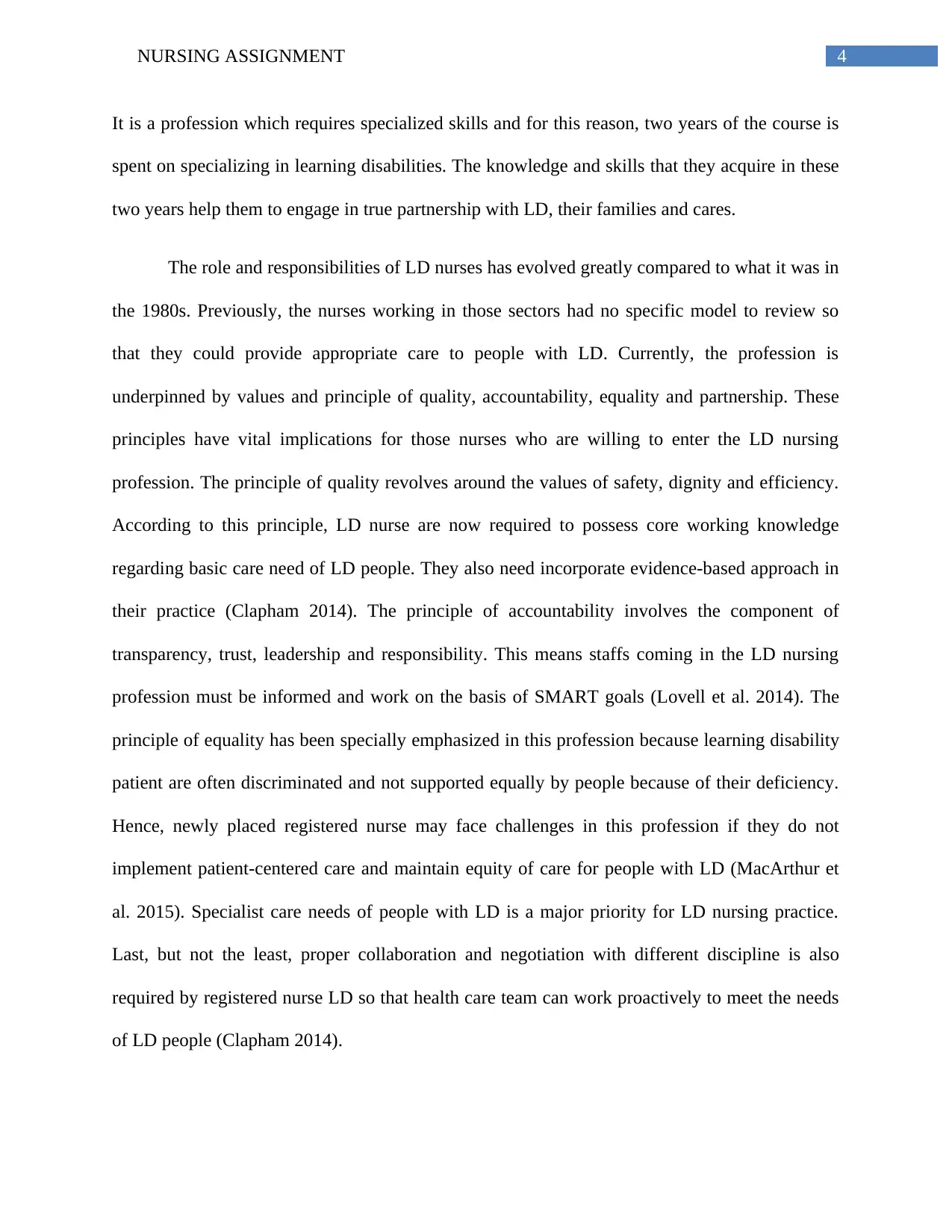
4NURSING ASSIGNMENT
It is a profession which requires specialized skills and for this reason, two years of the course is
spent on specializing in learning disabilities. The knowledge and skills that they acquire in these
two years help them to engage in true partnership with LD, their families and cares.
The role and responsibilities of LD nurses has evolved greatly compared to what it was in
the 1980s. Previously, the nurses working in those sectors had no specific model to review so
that they could provide appropriate care to people with LD. Currently, the profession is
underpinned by values and principle of quality, accountability, equality and partnership. These
principles have vital implications for those nurses who are willing to enter the LD nursing
profession. The principle of quality revolves around the values of safety, dignity and efficiency.
According to this principle, LD nurse are now required to possess core working knowledge
regarding basic care need of LD people. They also need incorporate evidence-based approach in
their practice (Clapham 2014). The principle of accountability involves the component of
transparency, trust, leadership and responsibility. This means staffs coming in the LD nursing
profession must be informed and work on the basis of SMART goals (Lovell et al. 2014). The
principle of equality has been specially emphasized in this profession because learning disability
patient are often discriminated and not supported equally by people because of their deficiency.
Hence, newly placed registered nurse may face challenges in this profession if they do not
implement patient-centered care and maintain equity of care for people with LD (MacArthur et
al. 2015). Specialist care needs of people with LD is a major priority for LD nursing practice.
Last, but not the least, proper collaboration and negotiation with different discipline is also
required by registered nurse LD so that health care team can work proactively to meet the needs
of LD people (Clapham 2014).
It is a profession which requires specialized skills and for this reason, two years of the course is
spent on specializing in learning disabilities. The knowledge and skills that they acquire in these
two years help them to engage in true partnership with LD, their families and cares.
The role and responsibilities of LD nurses has evolved greatly compared to what it was in
the 1980s. Previously, the nurses working in those sectors had no specific model to review so
that they could provide appropriate care to people with LD. Currently, the profession is
underpinned by values and principle of quality, accountability, equality and partnership. These
principles have vital implications for those nurses who are willing to enter the LD nursing
profession. The principle of quality revolves around the values of safety, dignity and efficiency.
According to this principle, LD nurse are now required to possess core working knowledge
regarding basic care need of LD people. They also need incorporate evidence-based approach in
their practice (Clapham 2014). The principle of accountability involves the component of
transparency, trust, leadership and responsibility. This means staffs coming in the LD nursing
profession must be informed and work on the basis of SMART goals (Lovell et al. 2014). The
principle of equality has been specially emphasized in this profession because learning disability
patient are often discriminated and not supported equally by people because of their deficiency.
Hence, newly placed registered nurse may face challenges in this profession if they do not
implement patient-centered care and maintain equity of care for people with LD (MacArthur et
al. 2015). Specialist care needs of people with LD is a major priority for LD nursing practice.
Last, but not the least, proper collaboration and negotiation with different discipline is also
required by registered nurse LD so that health care team can work proactively to meet the needs
of LD people (Clapham 2014).
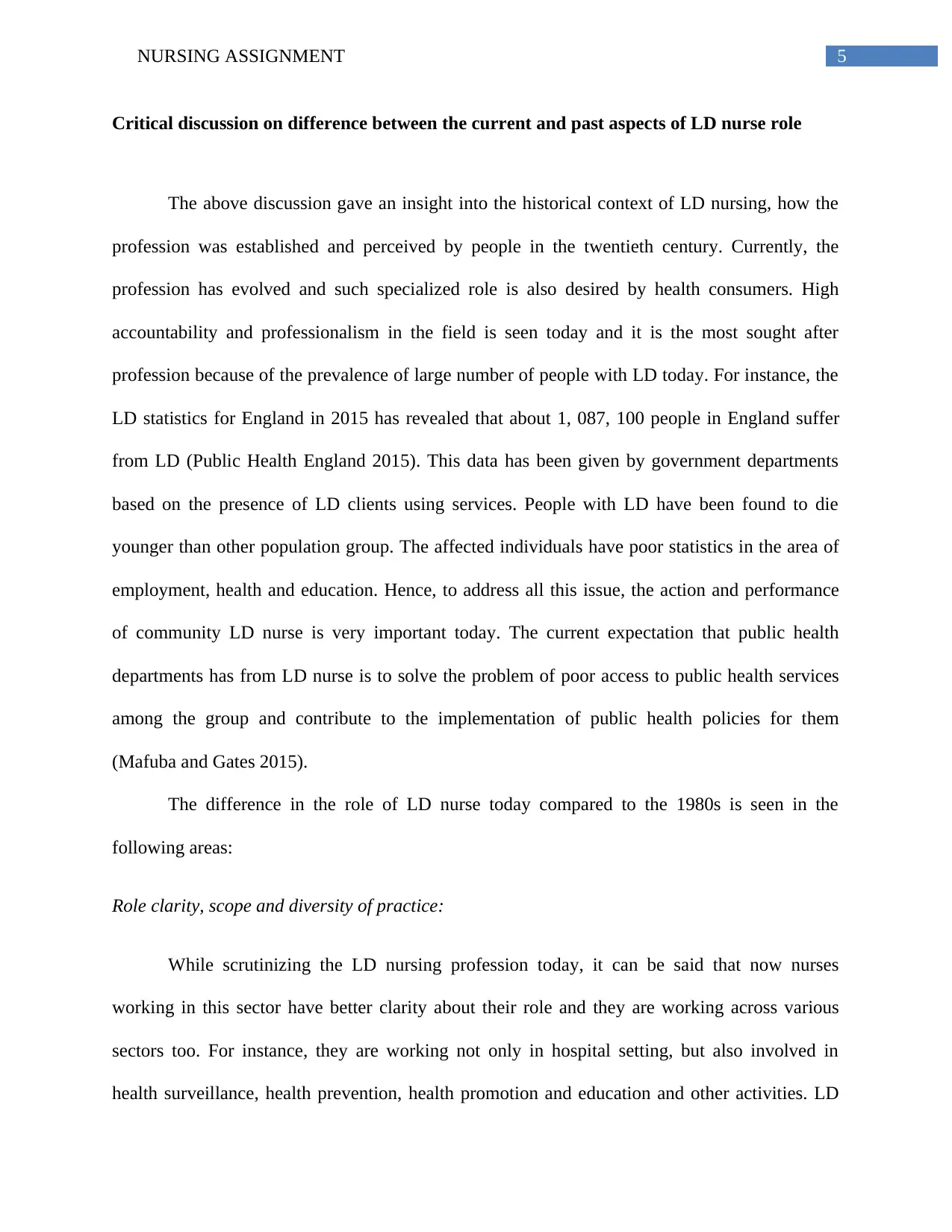
5NURSING ASSIGNMENT
Critical discussion on difference between the current and past aspects of LD nurse role
The above discussion gave an insight into the historical context of LD nursing, how the
profession was established and perceived by people in the twentieth century. Currently, the
profession has evolved and such specialized role is also desired by health consumers. High
accountability and professionalism in the field is seen today and it is the most sought after
profession because of the prevalence of large number of people with LD today. For instance, the
LD statistics for England in 2015 has revealed that about 1, 087, 100 people in England suffer
from LD (Public Health England 2015). This data has been given by government departments
based on the presence of LD clients using services. People with LD have been found to die
younger than other population group. The affected individuals have poor statistics in the area of
employment, health and education. Hence, to address all this issue, the action and performance
of community LD nurse is very important today. The current expectation that public health
departments has from LD nurse is to solve the problem of poor access to public health services
among the group and contribute to the implementation of public health policies for them
(Mafuba and Gates 2015).
The difference in the role of LD nurse today compared to the 1980s is seen in the
following areas:
Role clarity, scope and diversity of practice:
While scrutinizing the LD nursing profession today, it can be said that now nurses
working in this sector have better clarity about their role and they are working across various
sectors too. For instance, they are working not only in hospital setting, but also involved in
health surveillance, health prevention, health promotion and education and other activities. LD
Critical discussion on difference between the current and past aspects of LD nurse role
The above discussion gave an insight into the historical context of LD nursing, how the
profession was established and perceived by people in the twentieth century. Currently, the
profession has evolved and such specialized role is also desired by health consumers. High
accountability and professionalism in the field is seen today and it is the most sought after
profession because of the prevalence of large number of people with LD today. For instance, the
LD statistics for England in 2015 has revealed that about 1, 087, 100 people in England suffer
from LD (Public Health England 2015). This data has been given by government departments
based on the presence of LD clients using services. People with LD have been found to die
younger than other population group. The affected individuals have poor statistics in the area of
employment, health and education. Hence, to address all this issue, the action and performance
of community LD nurse is very important today. The current expectation that public health
departments has from LD nurse is to solve the problem of poor access to public health services
among the group and contribute to the implementation of public health policies for them
(Mafuba and Gates 2015).
The difference in the role of LD nurse today compared to the 1980s is seen in the
following areas:
Role clarity, scope and diversity of practice:
While scrutinizing the LD nursing profession today, it can be said that now nurses
working in this sector have better clarity about their role and they are working across various
sectors too. For instance, they are working not only in hospital setting, but also involved in
health surveillance, health prevention, health promotion and education and other activities. LD
⊘ This is a preview!⊘
Do you want full access?
Subscribe today to unlock all pages.

Trusted by 1+ million students worldwide
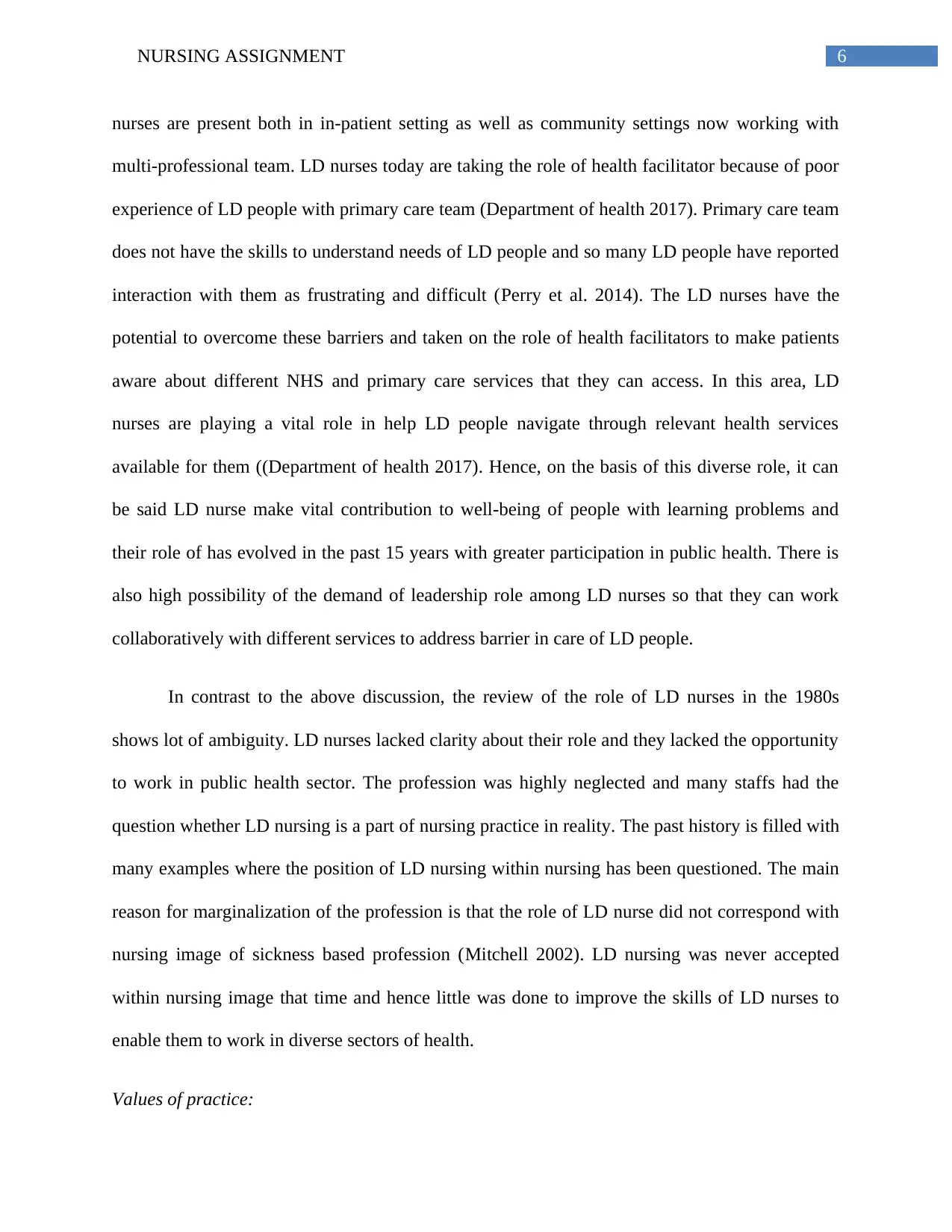
6NURSING ASSIGNMENT
nurses are present both in in-patient setting as well as community settings now working with
multi-professional team. LD nurses today are taking the role of health facilitator because of poor
experience of LD people with primary care team (Department of health 2017). Primary care team
does not have the skills to understand needs of LD people and so many LD people have reported
interaction with them as frustrating and difficult (Perry et al. 2014). The LD nurses have the
potential to overcome these barriers and taken on the role of health facilitators to make patients
aware about different NHS and primary care services that they can access. In this area, LD
nurses are playing a vital role in help LD people navigate through relevant health services
available for them ((Department of health 2017). Hence, on the basis of this diverse role, it can
be said LD nurse make vital contribution to well-being of people with learning problems and
their role of has evolved in the past 15 years with greater participation in public health. There is
also high possibility of the demand of leadership role among LD nurses so that they can work
collaboratively with different services to address barrier in care of LD people.
In contrast to the above discussion, the review of the role of LD nurses in the 1980s
shows lot of ambiguity. LD nurses lacked clarity about their role and they lacked the opportunity
to work in public health sector. The profession was highly neglected and many staffs had the
question whether LD nursing is a part of nursing practice in reality. The past history is filled with
many examples where the position of LD nursing within nursing has been questioned. The main
reason for marginalization of the profession is that the role of LD nurse did not correspond with
nursing image of sickness based profession (Mitchell 2002). LD nursing was never accepted
within nursing image that time and hence little was done to improve the skills of LD nurses to
enable them to work in diverse sectors of health.
Values of practice:
nurses are present both in in-patient setting as well as community settings now working with
multi-professional team. LD nurses today are taking the role of health facilitator because of poor
experience of LD people with primary care team (Department of health 2017). Primary care team
does not have the skills to understand needs of LD people and so many LD people have reported
interaction with them as frustrating and difficult (Perry et al. 2014). The LD nurses have the
potential to overcome these barriers and taken on the role of health facilitators to make patients
aware about different NHS and primary care services that they can access. In this area, LD
nurses are playing a vital role in help LD people navigate through relevant health services
available for them ((Department of health 2017). Hence, on the basis of this diverse role, it can
be said LD nurse make vital contribution to well-being of people with learning problems and
their role of has evolved in the past 15 years with greater participation in public health. There is
also high possibility of the demand of leadership role among LD nurses so that they can work
collaboratively with different services to address barrier in care of LD people.
In contrast to the above discussion, the review of the role of LD nurses in the 1980s
shows lot of ambiguity. LD nurses lacked clarity about their role and they lacked the opportunity
to work in public health sector. The profession was highly neglected and many staffs had the
question whether LD nursing is a part of nursing practice in reality. The past history is filled with
many examples where the position of LD nursing within nursing has been questioned. The main
reason for marginalization of the profession is that the role of LD nurse did not correspond with
nursing image of sickness based profession (Mitchell 2002). LD nursing was never accepted
within nursing image that time and hence little was done to improve the skills of LD nurses to
enable them to work in diverse sectors of health.
Values of practice:
Paraphrase This Document
Need a fresh take? Get an instant paraphrase of this document with our AI Paraphraser
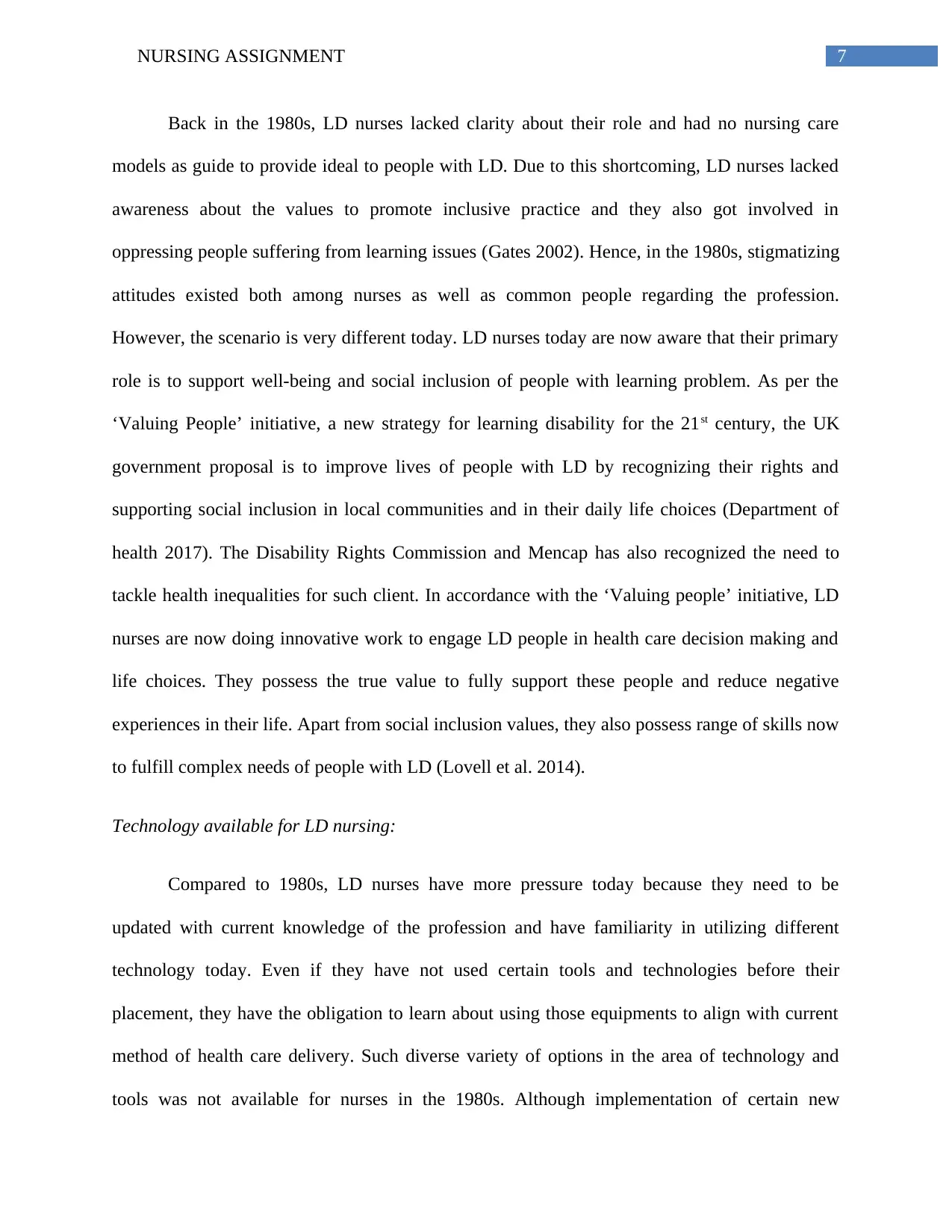
7NURSING ASSIGNMENT
Back in the 1980s, LD nurses lacked clarity about their role and had no nursing care
models as guide to provide ideal to people with LD. Due to this shortcoming, LD nurses lacked
awareness about the values to promote inclusive practice and they also got involved in
oppressing people suffering from learning issues (Gates 2002). Hence, in the 1980s, stigmatizing
attitudes existed both among nurses as well as common people regarding the profession.
However, the scenario is very different today. LD nurses today are now aware that their primary
role is to support well-being and social inclusion of people with learning problem. As per the
‘Valuing People’ initiative, a new strategy for learning disability for the 21st century, the UK
government proposal is to improve lives of people with LD by recognizing their rights and
supporting social inclusion in local communities and in their daily life choices (Department of
health 2017). The Disability Rights Commission and Mencap has also recognized the need to
tackle health inequalities for such client. In accordance with the ‘Valuing people’ initiative, LD
nurses are now doing innovative work to engage LD people in health care decision making and
life choices. They possess the true value to fully support these people and reduce negative
experiences in their life. Apart from social inclusion values, they also possess range of skills now
to fulfill complex needs of people with LD (Lovell et al. 2014).
Technology available for LD nursing:
Compared to 1980s, LD nurses have more pressure today because they need to be
updated with current knowledge of the profession and have familiarity in utilizing different
technology today. Even if they have not used certain tools and technologies before their
placement, they have the obligation to learn about using those equipments to align with current
method of health care delivery. Such diverse variety of options in the area of technology and
tools was not available for nurses in the 1980s. Although implementation of certain new
Back in the 1980s, LD nurses lacked clarity about their role and had no nursing care
models as guide to provide ideal to people with LD. Due to this shortcoming, LD nurses lacked
awareness about the values to promote inclusive practice and they also got involved in
oppressing people suffering from learning issues (Gates 2002). Hence, in the 1980s, stigmatizing
attitudes existed both among nurses as well as common people regarding the profession.
However, the scenario is very different today. LD nurses today are now aware that their primary
role is to support well-being and social inclusion of people with learning problem. As per the
‘Valuing People’ initiative, a new strategy for learning disability for the 21st century, the UK
government proposal is to improve lives of people with LD by recognizing their rights and
supporting social inclusion in local communities and in their daily life choices (Department of
health 2017). The Disability Rights Commission and Mencap has also recognized the need to
tackle health inequalities for such client. In accordance with the ‘Valuing people’ initiative, LD
nurses are now doing innovative work to engage LD people in health care decision making and
life choices. They possess the true value to fully support these people and reduce negative
experiences in their life. Apart from social inclusion values, they also possess range of skills now
to fulfill complex needs of people with LD (Lovell et al. 2014).
Technology available for LD nursing:
Compared to 1980s, LD nurses have more pressure today because they need to be
updated with current knowledge of the profession and have familiarity in utilizing different
technology today. Even if they have not used certain tools and technologies before their
placement, they have the obligation to learn about using those equipments to align with current
method of health care delivery. Such diverse variety of options in the area of technology and
tools was not available for nurses in the 1980s. Although implementation of certain new
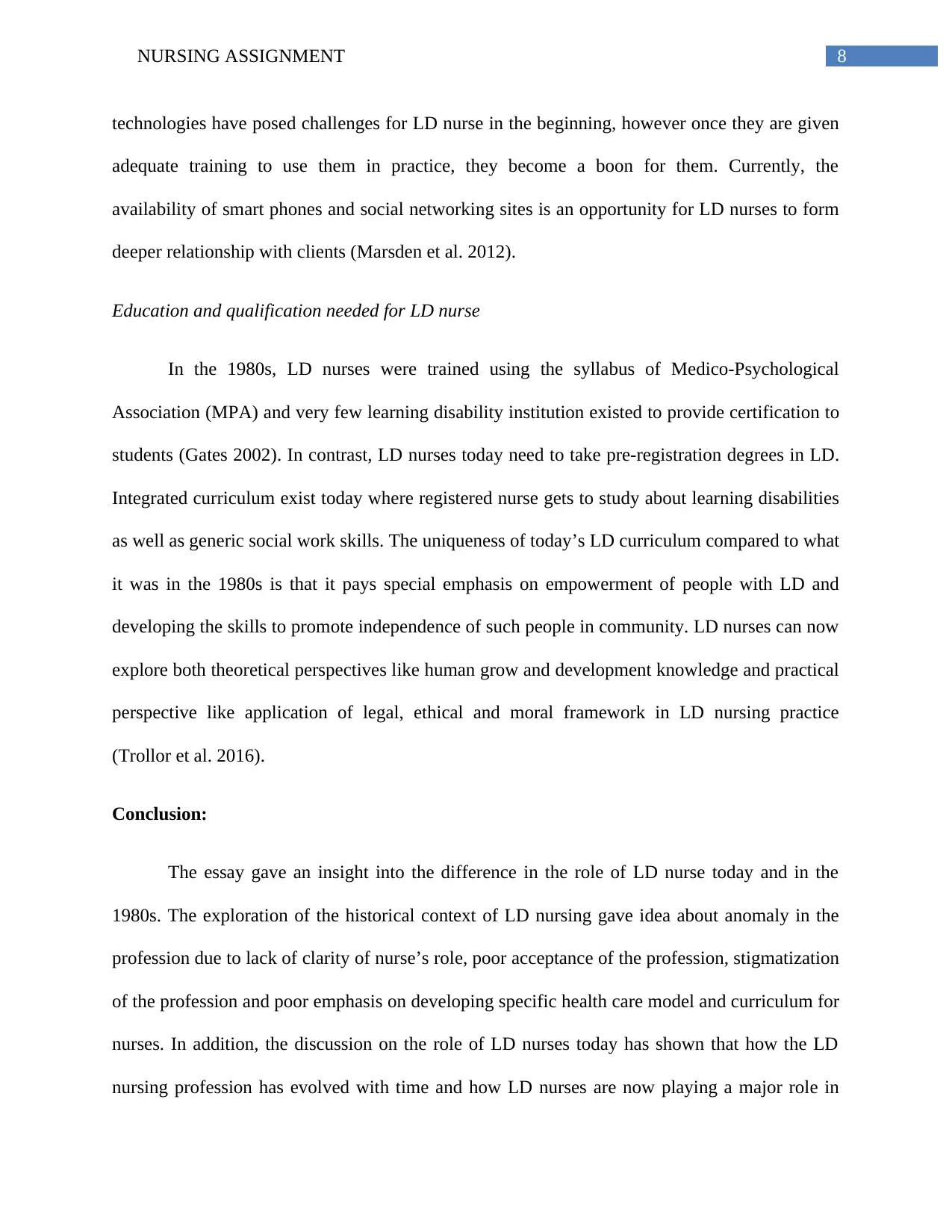
8NURSING ASSIGNMENT
technologies have posed challenges for LD nurse in the beginning, however once they are given
adequate training to use them in practice, they become a boon for them. Currently, the
availability of smart phones and social networking sites is an opportunity for LD nurses to form
deeper relationship with clients (Marsden et al. 2012).
Education and qualification needed for LD nurse
In the 1980s, LD nurses were trained using the syllabus of Medico-Psychological
Association (MPA) and very few learning disability institution existed to provide certification to
students (Gates 2002). In contrast, LD nurses today need to take pre-registration degrees in LD.
Integrated curriculum exist today where registered nurse gets to study about learning disabilities
as well as generic social work skills. The uniqueness of today’s LD curriculum compared to what
it was in the 1980s is that it pays special emphasis on empowerment of people with LD and
developing the skills to promote independence of such people in community. LD nurses can now
explore both theoretical perspectives like human grow and development knowledge and practical
perspective like application of legal, ethical and moral framework in LD nursing practice
(Trollor et al. 2016).
Conclusion:
The essay gave an insight into the difference in the role of LD nurse today and in the
1980s. The exploration of the historical context of LD nursing gave idea about anomaly in the
profession due to lack of clarity of nurse’s role, poor acceptance of the profession, stigmatization
of the profession and poor emphasis on developing specific health care model and curriculum for
nurses. In addition, the discussion on the role of LD nurses today has shown that how the LD
nursing profession has evolved with time and how LD nurses are now playing a major role in
technologies have posed challenges for LD nurse in the beginning, however once they are given
adequate training to use them in practice, they become a boon for them. Currently, the
availability of smart phones and social networking sites is an opportunity for LD nurses to form
deeper relationship with clients (Marsden et al. 2012).
Education and qualification needed for LD nurse
In the 1980s, LD nurses were trained using the syllabus of Medico-Psychological
Association (MPA) and very few learning disability institution existed to provide certification to
students (Gates 2002). In contrast, LD nurses today need to take pre-registration degrees in LD.
Integrated curriculum exist today where registered nurse gets to study about learning disabilities
as well as generic social work skills. The uniqueness of today’s LD curriculum compared to what
it was in the 1980s is that it pays special emphasis on empowerment of people with LD and
developing the skills to promote independence of such people in community. LD nurses can now
explore both theoretical perspectives like human grow and development knowledge and practical
perspective like application of legal, ethical and moral framework in LD nursing practice
(Trollor et al. 2016).
Conclusion:
The essay gave an insight into the difference in the role of LD nurse today and in the
1980s. The exploration of the historical context of LD nursing gave idea about anomaly in the
profession due to lack of clarity of nurse’s role, poor acceptance of the profession, stigmatization
of the profession and poor emphasis on developing specific health care model and curriculum for
nurses. In addition, the discussion on the role of LD nurses today has shown that how the LD
nursing profession has evolved with time and how LD nurses are now playing a major role in
⊘ This is a preview!⊘
Do you want full access?
Subscribe today to unlock all pages.

Trusted by 1+ million students worldwide
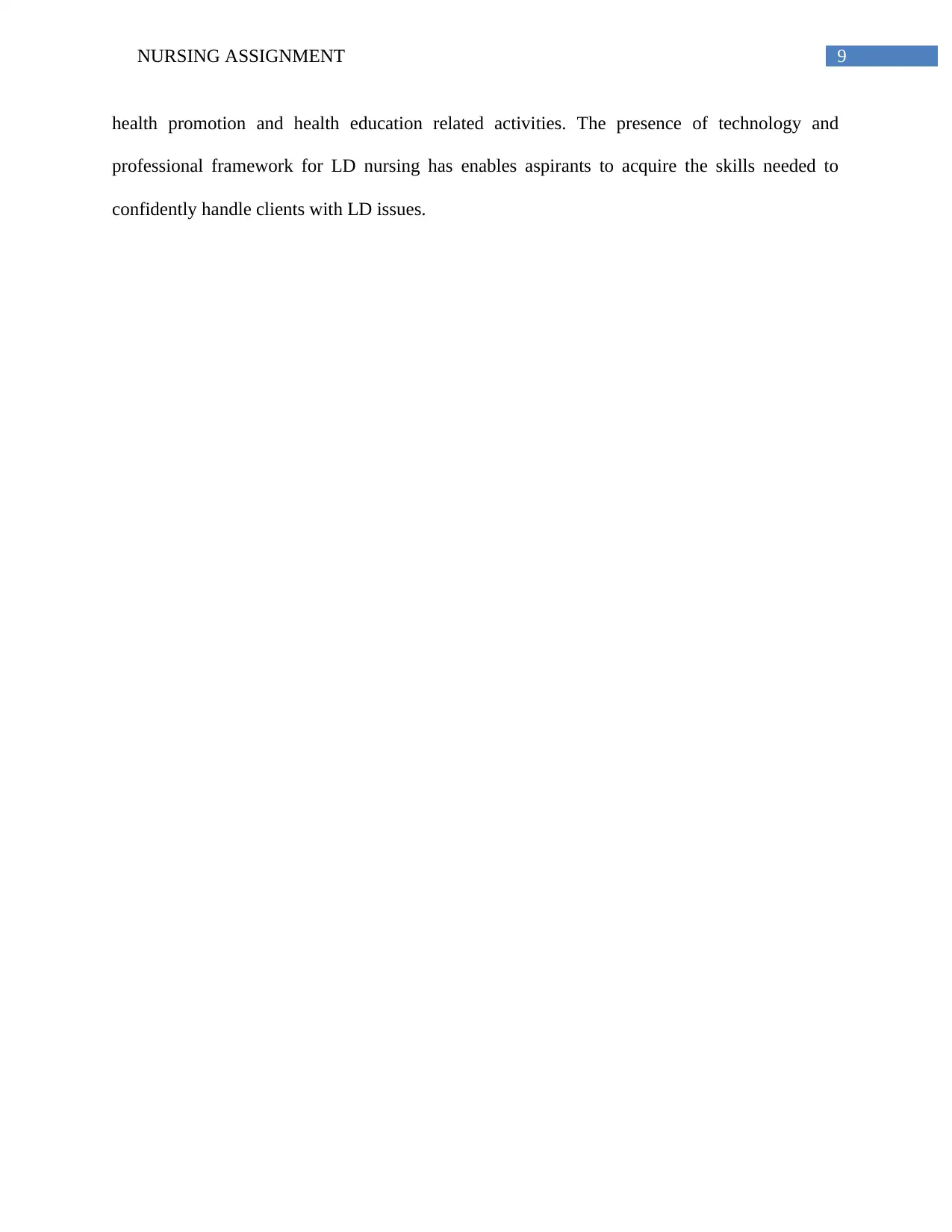
9NURSING ASSIGNMENT
health promotion and health education related activities. The presence of technology and
professional framework for LD nursing has enables aspirants to acquire the skills needed to
confidently handle clients with LD issues.
health promotion and health education related activities. The presence of technology and
professional framework for LD nursing has enables aspirants to acquire the skills needed to
confidently handle clients with LD issues.
Paraphrase This Document
Need a fresh take? Get an instant paraphrase of this document with our AI Paraphraser
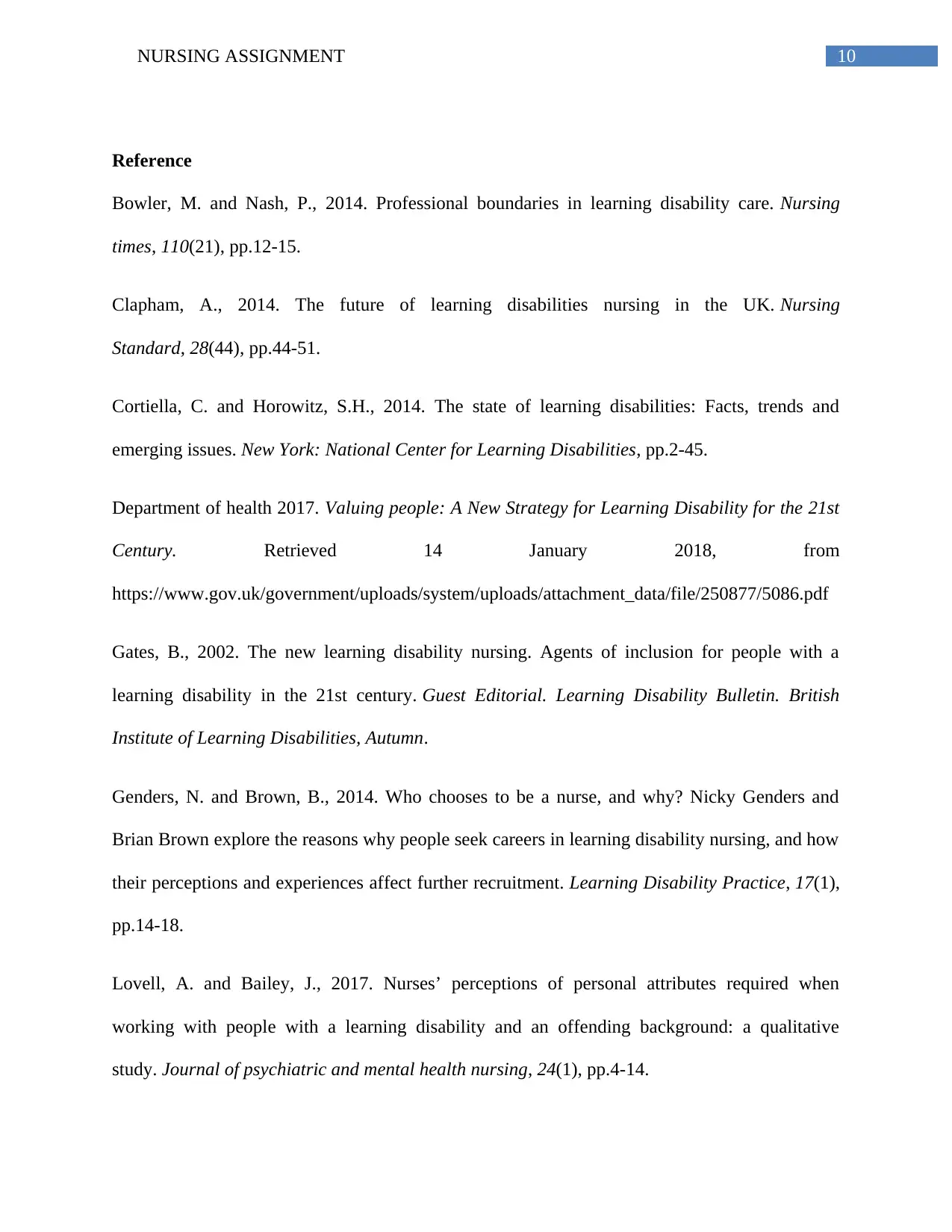
10NURSING ASSIGNMENT
Reference
Bowler, M. and Nash, P., 2014. Professional boundaries in learning disability care. Nursing
times, 110(21), pp.12-15.
Clapham, A., 2014. The future of learning disabilities nursing in the UK. Nursing
Standard, 28(44), pp.44-51.
Cortiella, C. and Horowitz, S.H., 2014. The state of learning disabilities: Facts, trends and
emerging issues. New York: National Center for Learning Disabilities, pp.2-45.
Department of health 2017. Valuing people: A New Strategy for Learning Disability for the 21st
Century. Retrieved 14 January 2018, from
https://www.gov.uk/government/uploads/system/uploads/attachment_data/file/250877/5086.pdf
Gates, B., 2002. The new learning disability nursing. Agents of inclusion for people with a
learning disability in the 21st century. Guest Editorial. Learning Disability Bulletin. British
Institute of Learning Disabilities, Autumn.
Genders, N. and Brown, B., 2014. Who chooses to be a nurse, and why? Nicky Genders and
Brian Brown explore the reasons why people seek careers in learning disability nursing, and how
their perceptions and experiences affect further recruitment. Learning Disability Practice, 17(1),
pp.14-18.
Lovell, A. and Bailey, J., 2017. Nurses’ perceptions of personal attributes required when
working with people with a learning disability and an offending background: a qualitative
study. Journal of psychiatric and mental health nursing, 24(1), pp.4-14.
Reference
Bowler, M. and Nash, P., 2014. Professional boundaries in learning disability care. Nursing
times, 110(21), pp.12-15.
Clapham, A., 2014. The future of learning disabilities nursing in the UK. Nursing
Standard, 28(44), pp.44-51.
Cortiella, C. and Horowitz, S.H., 2014. The state of learning disabilities: Facts, trends and
emerging issues. New York: National Center for Learning Disabilities, pp.2-45.
Department of health 2017. Valuing people: A New Strategy for Learning Disability for the 21st
Century. Retrieved 14 January 2018, from
https://www.gov.uk/government/uploads/system/uploads/attachment_data/file/250877/5086.pdf
Gates, B., 2002. The new learning disability nursing. Agents of inclusion for people with a
learning disability in the 21st century. Guest Editorial. Learning Disability Bulletin. British
Institute of Learning Disabilities, Autumn.
Genders, N. and Brown, B., 2014. Who chooses to be a nurse, and why? Nicky Genders and
Brian Brown explore the reasons why people seek careers in learning disability nursing, and how
their perceptions and experiences affect further recruitment. Learning Disability Practice, 17(1),
pp.14-18.
Lovell, A. and Bailey, J., 2017. Nurses’ perceptions of personal attributes required when
working with people with a learning disability and an offending background: a qualitative
study. Journal of psychiatric and mental health nursing, 24(1), pp.4-14.
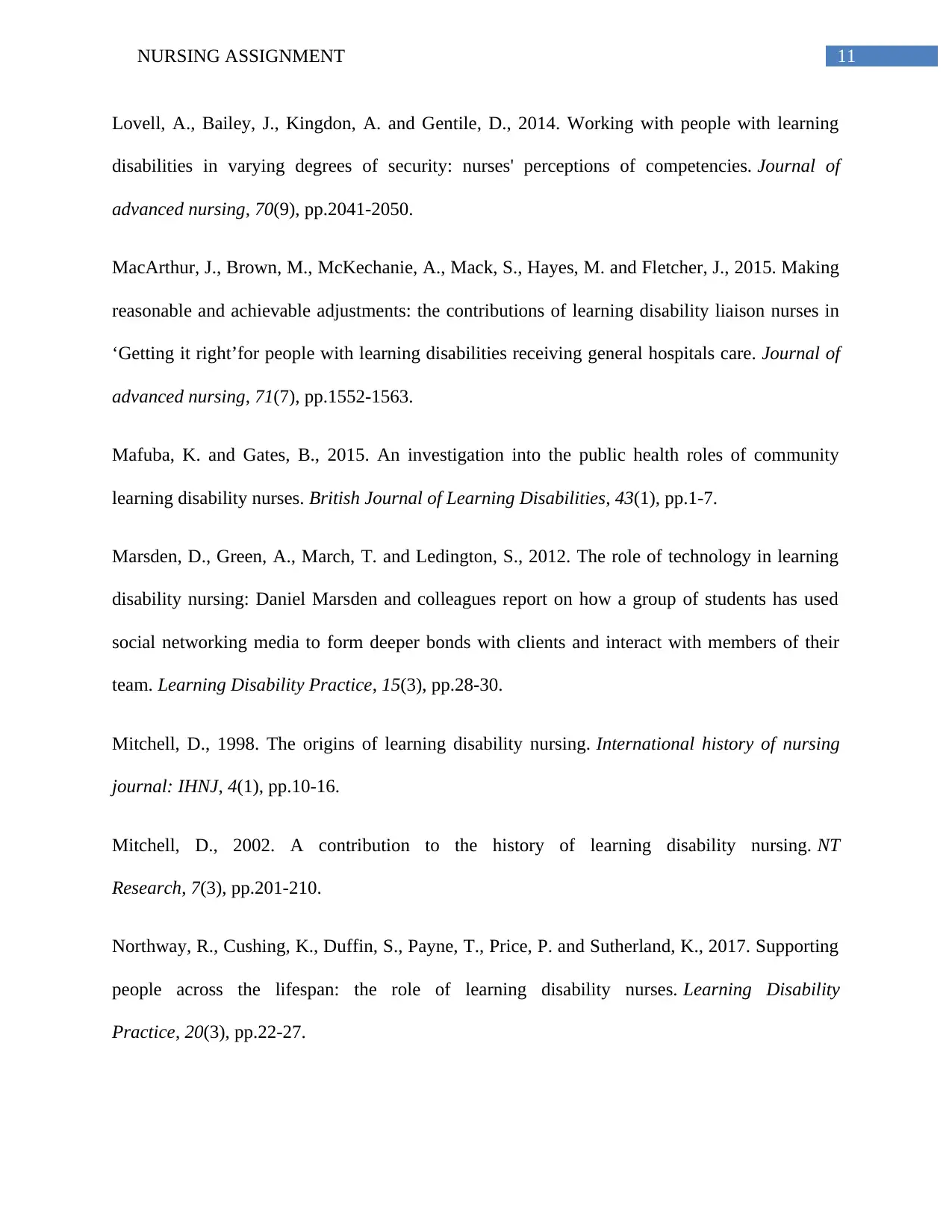
11NURSING ASSIGNMENT
Lovell, A., Bailey, J., Kingdon, A. and Gentile, D., 2014. Working with people with learning
disabilities in varying degrees of security: nurses' perceptions of competencies. Journal of
advanced nursing, 70(9), pp.2041-2050.
MacArthur, J., Brown, M., McKechanie, A., Mack, S., Hayes, M. and Fletcher, J., 2015. Making
reasonable and achievable adjustments: the contributions of learning disability liaison nurses in
‘Getting it right’for people with learning disabilities receiving general hospitals care. Journal of
advanced nursing, 71(7), pp.1552-1563.
Mafuba, K. and Gates, B., 2015. An investigation into the public health roles of community
learning disability nurses. British Journal of Learning Disabilities, 43(1), pp.1-7.
Marsden, D., Green, A., March, T. and Ledington, S., 2012. The role of technology in learning
disability nursing: Daniel Marsden and colleagues report on how a group of students has used
social networking media to form deeper bonds with clients and interact with members of their
team. Learning Disability Practice, 15(3), pp.28-30.
Mitchell, D., 1998. The origins of learning disability nursing. International history of nursing
journal: IHNJ, 4(1), pp.10-16.
Mitchell, D., 2002. A contribution to the history of learning disability nursing. NT
Research, 7(3), pp.201-210.
Northway, R., Cushing, K., Duffin, S., Payne, T., Price, P. and Sutherland, K., 2017. Supporting
people across the lifespan: the role of learning disability nurses. Learning Disability
Practice, 20(3), pp.22-27.
Lovell, A., Bailey, J., Kingdon, A. and Gentile, D., 2014. Working with people with learning
disabilities in varying degrees of security: nurses' perceptions of competencies. Journal of
advanced nursing, 70(9), pp.2041-2050.
MacArthur, J., Brown, M., McKechanie, A., Mack, S., Hayes, M. and Fletcher, J., 2015. Making
reasonable and achievable adjustments: the contributions of learning disability liaison nurses in
‘Getting it right’for people with learning disabilities receiving general hospitals care. Journal of
advanced nursing, 71(7), pp.1552-1563.
Mafuba, K. and Gates, B., 2015. An investigation into the public health roles of community
learning disability nurses. British Journal of Learning Disabilities, 43(1), pp.1-7.
Marsden, D., Green, A., March, T. and Ledington, S., 2012. The role of technology in learning
disability nursing: Daniel Marsden and colleagues report on how a group of students has used
social networking media to form deeper bonds with clients and interact with members of their
team. Learning Disability Practice, 15(3), pp.28-30.
Mitchell, D., 1998. The origins of learning disability nursing. International history of nursing
journal: IHNJ, 4(1), pp.10-16.
Mitchell, D., 2002. A contribution to the history of learning disability nursing. NT
Research, 7(3), pp.201-210.
Northway, R., Cushing, K., Duffin, S., Payne, T., Price, P. and Sutherland, K., 2017. Supporting
people across the lifespan: the role of learning disability nurses. Learning Disability
Practice, 20(3), pp.22-27.
⊘ This is a preview!⊘
Do you want full access?
Subscribe today to unlock all pages.

Trusted by 1+ million students worldwide
1 out of 13
Related Documents
Your All-in-One AI-Powered Toolkit for Academic Success.
+13062052269
info@desklib.com
Available 24*7 on WhatsApp / Email
![[object Object]](/_next/static/media/star-bottom.7253800d.svg)
Unlock your academic potential
Copyright © 2020–2025 A2Z Services. All Rights Reserved. Developed and managed by ZUCOL.





